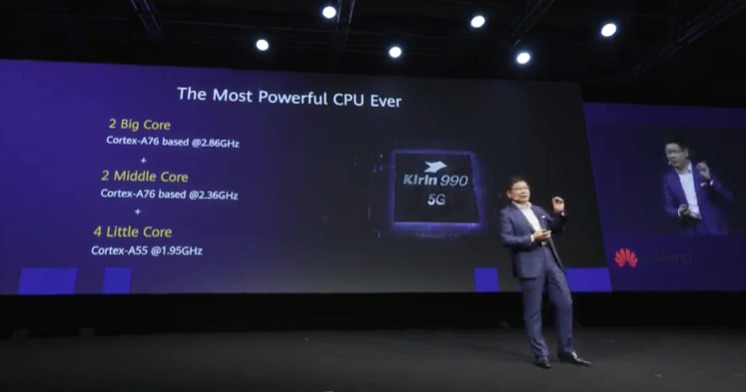At IFA, Huawei has unveiled the latest flagship Kirin 990 series SoC: Kirin 990 and its 5G version. Huawei’s Kirin 990 (5G) is the first 5G SoC in the world and supports the industry’s most compact 5G smartphone solution. It has cutting-edge 7 nm+ EUV manufacturing process and is integrated with a 5G modem, achieving a smaller area and lower power consumption.

Moreover, Kirin 990 (5G) is the first full-frequency 5G SoC to support both non-standalone (NSA) and standalone (SA) architectures as well as TDD/FDD full frequency bands, enabling it to accommodate hardware requirements under diverse networks and networking modes. Based on Balong 5000’s excellent 5G connectivity capability, Kirin 990 (5G) provides a leading peak downlink rate of 2.3 Gbit/s and an uplink peak rate of 1.25 Gbit/s, delivering unmatched 5G experiences in the industry as stated by Huawei.
Kirin 990 (5G) is the first flagship SoC that packs a dual-core NPU built on the Da Vinci architecture, which comprise large NPU cores and tiny NPU cores. The large cores achieve high performance and power efficiency in heavy computing scenarios, while the tiny core structure, first in the industry, empowers ultra-low power consumption applications, fully tapping into the intelligent computing power brought by the innovative NPU architecture.
In terms of CPU, Kirin 990 features a three-level power efficiency structure, comprising of two ultra-large cores, two large cores, and four small cores, with a dominant frequency up to 2.86 GHz. In addition, Kirin 990 uses a 16-core Mali-G76 GPU and the new system-level Smart Cache for intelligent flow distribution, which can effectively save bandwidth and lower power consumption. For gaming experiences, Kirin 990 (5G) supports an upgraded Kirin Gaming+ 2.0 that enables efficient collaboration between hardware infrastructure and solutions, offering industry-leading smooth and fast gaming experience.
As for photography, Kirin 990 (5G) provides a brand-new ISP 5.0 that pioneers block-matching and 3D filtering (BM3D) professional-level hardware noise reduction (NR) for capturing brighter and sharper images in low light environments. It is also the first to use dual-domain video NR for more accurate noise processing for videos. In addition, the real-time video post-processing and rendering based on AI segmentation can adjust the image color frame by frame to bring cinematic quality.
The Huawei Kirin 990 and Kirin 990 5G SoCs will power the upcoming Mate 30 series.



















